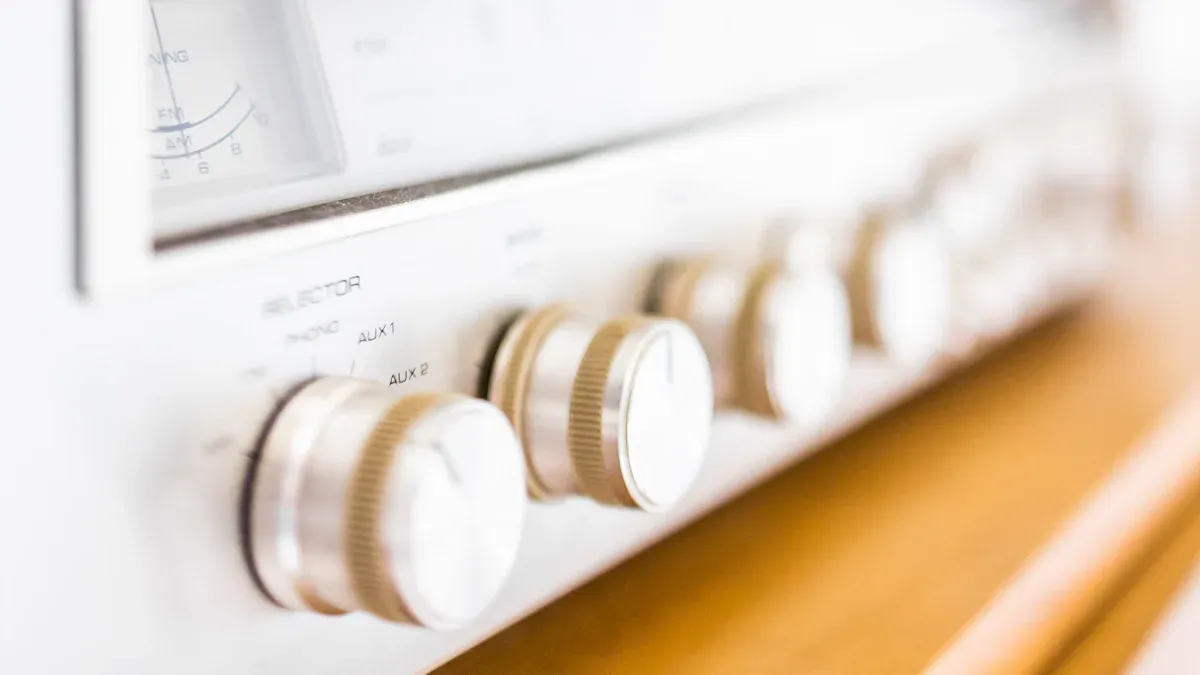
Choosing the right amplifier for your home audio system ensures you get the best sound possible from your music and movies. You need to match amplifier power and impedance to your speakers for optimal sound quality and to protect your equipment.
Amplifiers with low output impedance keep your speakers under control, reducing distortion and delivering clear sound.
If you use speakers with too low impedance, you risk damaging your amplifier and reducing its lifespan.
Proper matching lets you enjoy high-quality audio at home without worry.
With a focus on these key factors, you can confidently select an amplifier that brings your home audio to life.
Key Takeaways
Match your amplifier’s power and impedance to your speakers to get clear sound and protect your equipment.
Choose an amplifier with about 1.5 to 2 times the continuous power rating of your speakers for clean, distortion-free audio.
Check speaker sensitivity and impedance carefully to know how much power your amplifier needs to deliver.
Pick the right number of amplifier channels based on your speaker setup, like stereo or surround sound.
Avoid common mistakes like overpowering, underpowering, or mismatching impedance to keep your system safe and sounding great.
System Matching
Selecting the right amplifier for your home audio system starts with system matching. You need to ensure that your amplifier and speakers work together for the best performance and safety. This process involves understanding speaker specifications, impedance, and power ratings. When you match your amp to your speakers correctly, you protect your equipment and achieve high-quality sound.
Speaker Specs
When pairing your speakers with an amplifier, focus on these key specifications:
Nominal Impedance: Check the speaker’s impedance, usually 4, 6, or 8 ohms. Your amplifier must support this value for safe operation.
Power Handling: Look at the continuous power rating (RMS) of your speakers. This tells you how much power they can handle over time.
Sensitivity: This measures how loud your speakers get with a certain amount of power. Higher sensitivity means you need less amplifier power for the same volume.
Amplifier Power Selection: Choose an amplifier that delivers about 1.5 to 2 times your speaker’s continuous power rating. This gives you headroom and prevents distortion.
Avoid Underpowered Amplifiers: Using an amplifier with too little power can cause clipping and damage your speakers.
Avoid Overdriving Speakers: Too much power can also harm your speakers. Control the volume to prevent distortion.
Tip: Always read your speaker’s manual for exact specs before you match your amp.
Speaker sensitivity plays a big role in amplifier power needs. For example, if your speakers have lower sensitivity, you need more power to reach the same loudness. The chart below shows how lower sensitivity and impedance require more amplifier power:
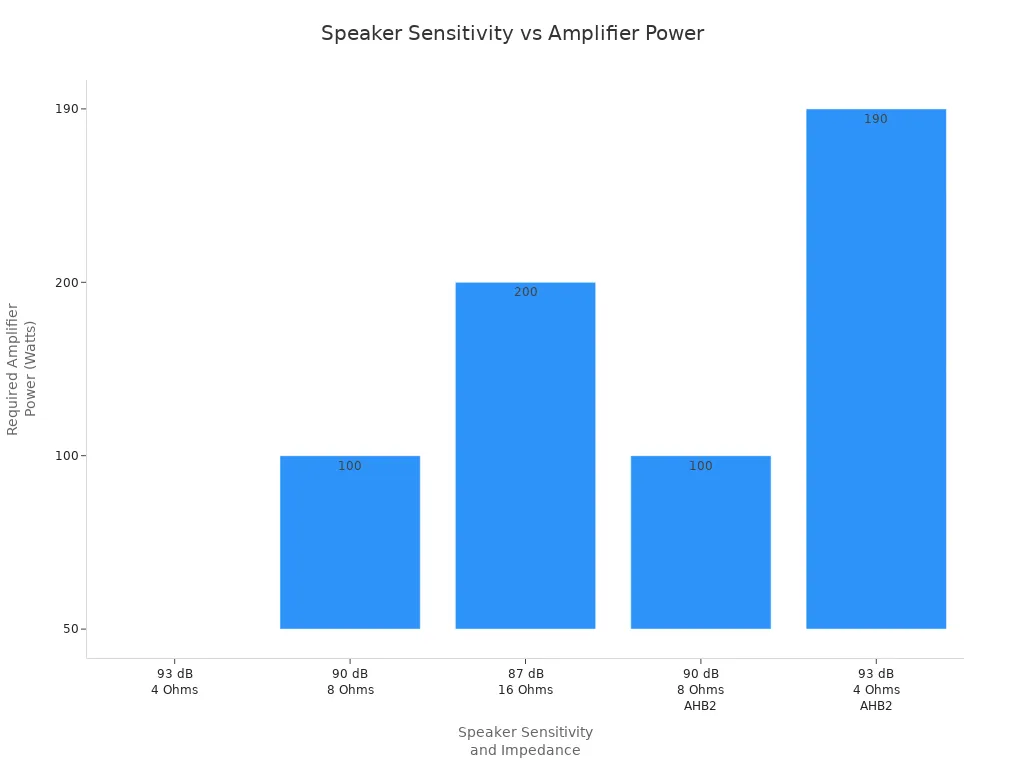
Impedance
Matching amplifier and speaker impedance is critical for system stability and sound quality. Most home audio speakers have an impedance between 4 and 8 ohms. Your amplifier should support the same range. If you use speakers with lower impedance, they draw more current. This can overload your amplifier, causing distortion or even damage. Higher impedance speakers are easier on your amplifier but may affect volume.
Matching impedance ensures efficient power transfer.
It prevents signal loss and distortion.
It protects your amplifier from overheating and failure.
Most modern amplifiers, including Lihui Pro Sound Amplifier models, support 4, 6, and 8-ohm speakers. Always check the amplifier’s manual to confirm the supported impedance range before pairing your speakers.
Power Ratings
Power ratings are essential for system matching. You want your amplifier power output to align with your speaker’s continuous power rating. The industry standard recommends selecting an amplifier with an RMS power rating about 1.5 to 2 times higher than your speaker’s RMS rating. This extra headroom helps prevent amplifier clipping and keeps your sound clean.
Amplifier power output should be about double the speaker’s continuous power rating.
This prevents distortion and protects your speakers.
Avoid using an amplifier with less power than your speakers need.
Lihui Pro Sound Amplifier models offer a range of power amplifier options for different needs. For example, the TLC2400 Touring Audio Amplifier delivers 2400W across two channels, making it ideal for high-demand setups. The 1U 2 Channel Digital Amplifier provides 1800W with precise sound control. These amplifiers feature high signal-to-noise ratios and advanced circuit protection, ensuring reliable performance and equipment safety.
| Model Description | Power Rating | Channels | Technology | Signal-to-Noise Ratio | Frequency Response | Key Features |
| 1U 2 Channel Digital Amplifier | 1800W | 2 | Class D Digital | ≥105 dB | 20Hz-20kHz ±0.5dB | High power, precise sound control |
| TLC2400 Touring Audio Amplifier | 2400W | 2 | Class D Digital | ≥105 dB | 20Hz-20kHz ±0.5dB | Aluminum radiator, tone control |
| 4 Channel Stage Amplifier | 2400W total | 4 | Class D Digital | ≥105 dB | 20Hz-20kHz ±0.5dB | Individual volume control |
| 1U 4 Channel Performing Arts Amplifier | 2000W | 4 | Class D Digital | ≥105 dB | 20Hz-20kHz ±0.5dB | Circuit protection, durable casing |
When you match your amp to your speakers using these guidelines, you ensure optimal performance, long-term reliability, and the best possible audio experience. System matching is the foundation of any great home audio setup.
Choosing the Right Amplifier
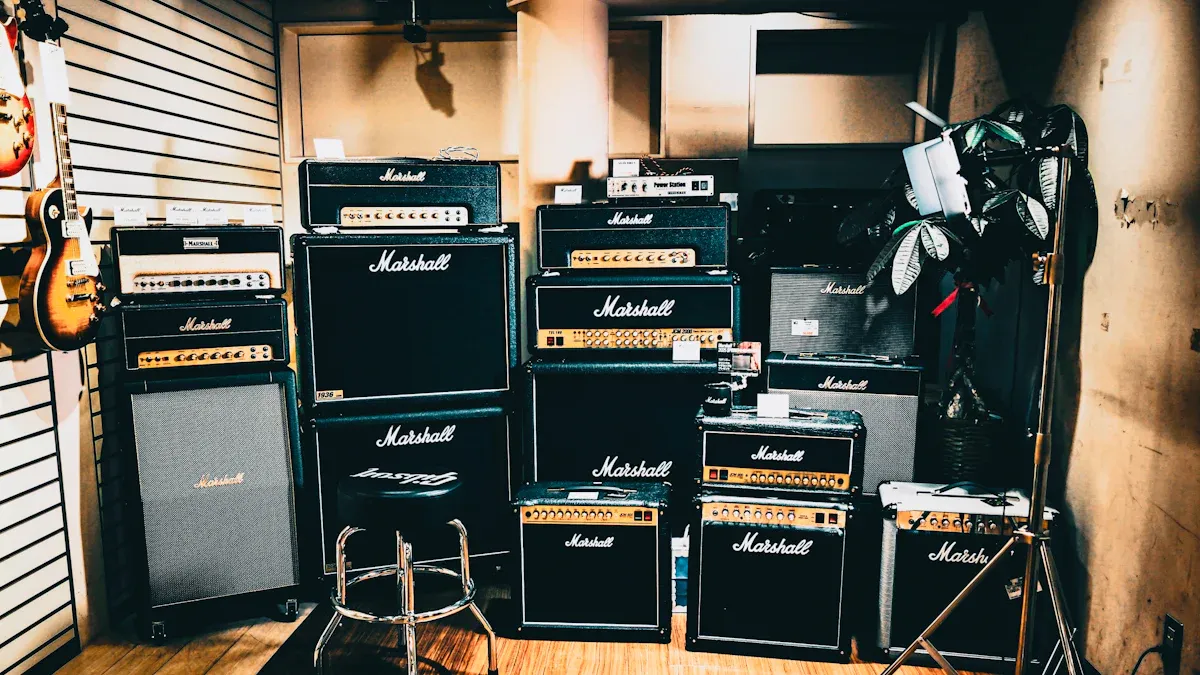
Channels
When choosing the right amplifier for your home audio system, you must first decide how many channels you need. The number of channels determines how many speakers or zones you can power. For a classic stereo setup, you need a two-channel amplifier. This setup is perfect for listening to music in one room with left and right speakers. If you want surround sound for movies, a receiver with five or more channels is necessary. Each channel powers a different speaker, such as front, rear, center, and subwoofer. Multi-room audio setups require amplifiers with multiple channels, sometimes up to twelve, so you can play music in different rooms at the same time. The way you wire your speakers—parallel or series—also affects the total impedance and power draw. Always match the amplifier type to your speaker arrangement and check that the power and impedance ratings are compatible. This ensures safe operation and top performance.
Features
Modern amplifiers offer a range of features that enhance your listening experience. Look for amplifiers with multiple inputs, such as XLR, RCA, and digital connections, so you can connect various music sources. Tone controls let you adjust bass and treble for the best sound in your room. Advanced amplifiers include digital signal processing (DSP) for precise control over stereo sound and room correction. Cooling systems, like temperature-controlled fans and aluminum radiators, keep the amplifier running smoothly during long listening sessions. Protection devices, such as short circuit protection and electronic turn-on delay, guard against electrical faults and overheating. Lihui’s Pro Sound Amplifier models stand out with high power output, advanced circuit protection, and efficient cooling, making them reliable for any stereo or multi-room setup.
Connectivity
Connections are crucial when choosing the right amplifier. You want an amplifier that supports all your audio sources and future upgrades. Essential connections include analog audio inputs for CD players, digital optical and coaxial inputs for TVs and media players, and USB ports for music files. Wireless options like Bluetooth and Wi-Fi allow you to stream music from your phone or tablet. HDMI and network connections support modern receivers and multi-room audio systems. Lihui’s Pro Sound Amplifier range offers versatile connections, including XLR pairs and AES67 networking, making it easy to integrate with any stereo or surround sound setup. Reliable connections ensure you enjoy high-quality music and seamless performance across your entire system.
Stereo Amplifier Options
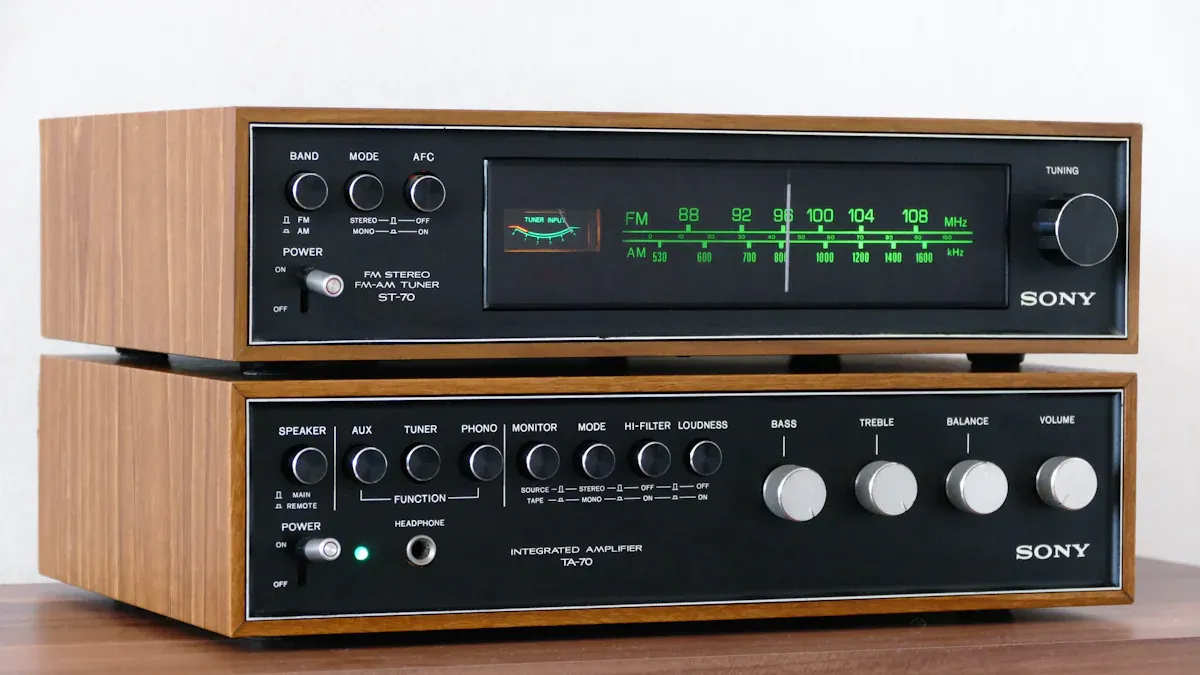
Integrated vs Separate
When you choose a stereo amplifier, you face a key decision: integrated amplifier or separate components. An integrated amplifier combines the preamplifier and power amplifier in one unit. This design saves space and reduces the number of cables you need. You get a simple setup that fits well in most home environments. Many music lovers prefer integrated amplifiers for their convenience and value.
Separate amplifiers, on the other hand, split the preamp and power amplifier into two units. This approach gives you more flexibility to upgrade or fine-tune your system. Audiophiles often choose separates for the best possible sound and customization. You can select a high-end preamp and match it with a dedicated power amplifier for each channel. This setup improves channel separation and allows longer speaker cable runs.
Here’s a quick comparison to help you decide:
| Feature/Aspect | Integrated Amplifiers | Separate Amplifiers |
| Components | Combines preamp and power amplifier in one unit | Separate preamp and power amplifier components |
| Suitability | Ideal for most music lovers seeking simplicity | Favored by audiophiles seeking ultimate customization |
| Advantages | Simplicity, space-saving, value, fewer cables | Greater flexibility, advanced features, fine-tuning |
| Technical considerations | Shorter signal path, convenience | Dedicated power supplies, better channel separation |
| Upgradeability | Limited to the integrated unit | Easier to upgrade individual components |
| Use case | Streamlined setups | Customization and potential performance gains |
Lihui offers stereo amplifier models that fit both needs. The MD800 series, for example, provides balanced power and advanced DSP features in a compact, durable chassis. You can use these as integrated amplifiers for a clean, simple setup or pair them with other components for a more advanced system.
Power Needs
Selecting the right amplifier power for your stereo system ensures you get clear, dynamic sound without distortion. Several factors affect your power requirements:
Speaker sensitivity: Higher sensitivity means you need less power for the same volume.
Desired listening level: Louder music or larger rooms require more amplifier power.
Room acoustics: Soft furnishings and room size can absorb sound, increasing power needs.
Music genre: Dynamic music with strong peaks needs extra headroom to avoid clipping.
Most home stereo setups perform well with an amplifier that delivers 1.6 to 2.5 times the continuous power rating of your speakers. More power gives you cleaner sound and better handling of music peaks. Lihui stereo amplifier models, such as the 1U Class D and MD800 series, deliver 800 to 2400 watts per channel with low distortion and high signal-to-noise ratios. These amplifiers provide enough headroom for demanding music and larger rooms.
| Feature | Description |
| Power Output | 1800–2400 Watts |
| Frequency Response | 20Hz – 20kHz |
| Channels | 2 (Stereo) |
| Distortion Level | -0.5 dB |
| Input Sensitivity | 0.775V / 1V |
| Construction | Durable metal chassis |
| Suitability | Home stereo, theater, and professional venues |
You can see how Lihui amplifiers compare to industry standards in the chart below:
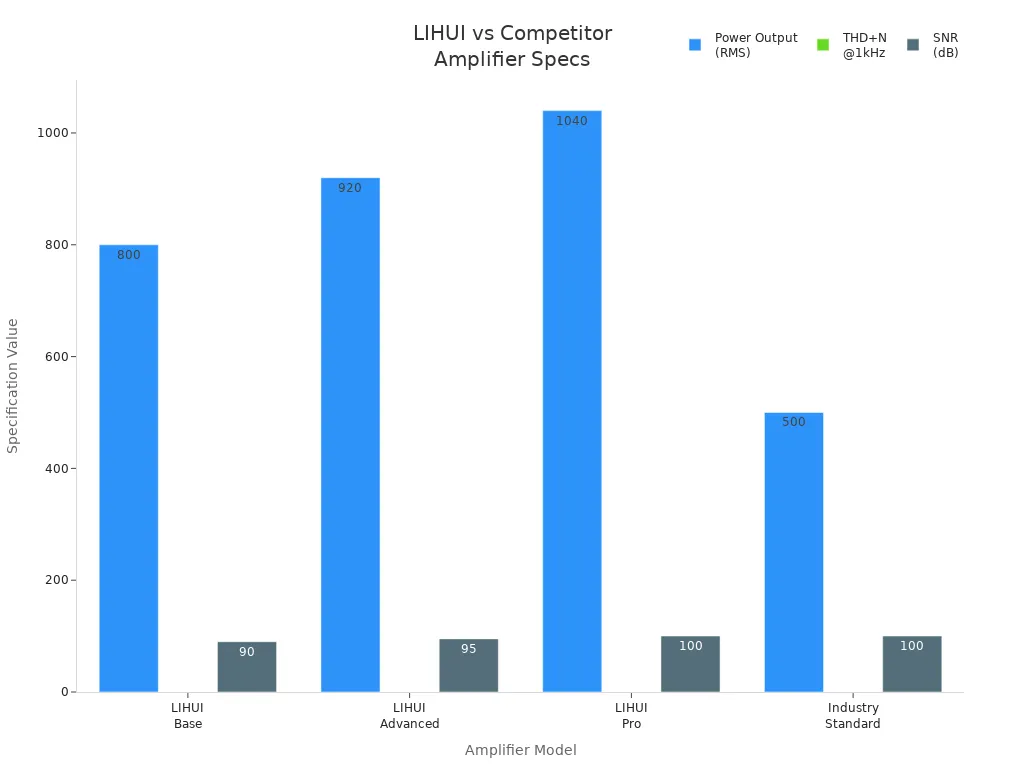
Tip: Choose an amplifier with more power than you think you need. This approach ensures clean sound and protects your speakers from distortion.
Mistakes to Avoid
When building your home audio system, you can avoid many common pitfalls by understanding the most frequent mistakes. Paying attention to these issues helps you protect your investment and enjoy reliable, high-quality sound.
Overpowering
Giving your speakers too much power can lead to serious damage. If you use an amplifier with a much higher output than your speakers can handle, you risk overheating the voice coils and causing permanent failure. This usually happens when you push the volume too high for long periods. However, having a powerful amplifier is not always a problem. You can safely use a higher-wattage amplifier if you manage the volume and avoid exceeding your speakers’ limits.
Tip: Use common sense with volume control. Clean, undistorted power is safer than pushing a weak amplifier into distortion.
Underpowering
Using an amplifier that is too weak for your speakers often causes more harm than overpowering. When an underpowered amplifier struggles to deliver enough power, it produces distortion, especially at high volumes. This distortion can quickly damage the delicate drivers in your speakers, particularly the tweeters. You also lose sound quality and dynamic range. Always choose an amplifier that matches or slightly exceeds your speakers’ continuous power rating to maintain performance and protect your equipment.
Underpowered systems often sound flat and lifeless.
Distortion from clipping can destroy speaker components.
Proper matching extends the lifespan of your speakers.
Mismatched Impedance
Impedance mismatch between your amplifier and speakers can cause several problems:
Reduced power output and lower volume.
Overheating and possible damage to your amplifier.
Distorted sound and poor performance.
Amplifier protection circuits may shut down your system.
Always check the impedance ratings for both your amplifier and speakers. Never connect speakers with lower impedance than your amplifier supports, especially at high volumes. This practice prevents overheating and keeps your system running smoothly.
Note: Matching impedance ensures efficient power transfer and protects both your amplifier and speakers from damage.
Common mistakes to avoid include:
Buying an amplifier before selecting your speakers.
Using gear that does not fit your room size or speaker sensitivity.
Spending too much on one component while neglecting others.
Failing to calibrate your system for balanced sound.
By following these guidelines, you ensure long-term reliability and the best possible listening experience.
Tips for Choosing an Amplifier
Checklist
When you choose an amplifier for your home audio setup, following a step-by-step checklist helps you avoid common mistakes and ensures the best compatibility. Use this guide to make the process simple and effective:
Check the impedance ratings for both your amplifier and speakers. The amplifier’s minimum impedance must match or be less than the speaker’s nominal impedance.
Match the amplifier’s continuous power output (RMS) with your speakers’ recommended power handling. This prevents damage and keeps your sound clear.
Understand your speakers’ sensitivity. This helps you gauge how loud your system will be and ensures your amplifier can deliver enough power for your room.
Avoid mismatches. Do not pair a high-power amplifier with low-capacity speakers or a low-power amplifier with high-powered speakers.
Use online calculators to check impedance and power matching. These tools make compatibility checks easier.
Consider spending similar amounts on your amplifier and speakers or choose one brand for both. This reduces the risk of mismatch and improves overall sound quality.
Remember that proper matching extends the life of your equipment and enhances your listening experience.
Tip: Always review the manufacturer’s specifications for both your amplifier and speakers before making a final decision.
Final Compatibility
Before you buy, double-check compatibility to ensure your system works perfectly now and in the future. Start by matching wattage and impedance ranges between your amplifier and speakers. Consider your room size, speaker placement, and desired volume level. Use tools like power calculators to determine the right amplifier output for your needs.
Plan for future expansion. Choose an amplifier with extra channels or higher power if you want to add more speakers or zones later. Look for features like Bluetooth, HDMI, or streaming support to keep your setup flexible.
| Factor | Why It Matters |
| Amplifier Power Needs | Supports future, more demanding speakers |
| Number of Channels | Allows for surround sound or multi-room audio |
| Speaker Compatibility | Prevents damage and ensures optimal performance |
| Additional Features | Provides flexibility for upgrades and new technology |
Note: Buying amplifier and speakers from the same manufacturer can simplify compatibility and improve sound quality.
You can achieve outstanding audio performance by following these essential steps:
Match amplifier and speaker impedance for efficient power transfer and clear sound.
Select amplifier power that fits your speaker’s needs to protect equipment and maintain music quality.
Consider speaker sensitivity and frequency response for balanced, natural sound.
Use a checklist to verify connections and compatibility.
Double-check every detail to ensure your system delivers reliable, high-quality sound for years. When you make informed choices, you enjoy music with confidence and lasting satisfaction.
FAQ
What is the most important factor when choosing the right amplifier for my home audio system?
You should focus on system matching. Check the amplifier power rating and impedance to match your speakers. This ensures optimal sound quality, protects your equipment, and delivers the best sound possible for your home setup.
Can I use any amplifier with my speakers for a home stereo setup?
No, you need to match your amp to your speakers. Pairing your speakers with the wrong amplifier can cause poor performance or damage. Always check compatibility, including power, impedance, and connections, before you choose an amplifier for your home stereo.
How does amplifier power affect sound quality in my music system?
Amplifier power directly impacts sound quality and performance. Too little power can cause distortion, while too much can damage your speakers. Choose an amplifier with a power rating that matches your speakers for clear music and optimal sound quality in your home audio system.
Should I choose an integrated amplifier or separate preamp and power amplifier for my home stereo?
An integrated amplifier combines preamp and power amplifier in one unit, saving space and simplifying your setup. Separate components offer more flexibility and upgrade options. Your choice depends on your system needs, available space, and desired audio quality.
What connections do I need for my amplifier and receiver in a modern home audio setup?
You need connections that support your audio sources. Look for analog, digital, and wireless options. HDMI, RCA, and Bluetooth connections help you achieve compatibility with your receiver, speakers, and music devices, ensuring the best sound and performance in your home system.

























